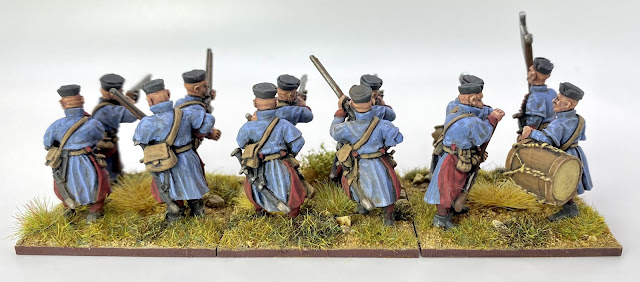In this blog post I cover a new addition to my Polish-Lithuanian Commonwealth army, a unit of Polish Haiduks.
 |
| Polish Haiduks - 28mm from Wargames Foundry & TAG |
My painting progress over the summer and autumn has been almost nonexistent and so I am really pleased to be back in the saddle, so to speak!
Haiduk (or Hajduk) was a term used in this period for native Polish and Hungarian infantry. They were armed with muskets and provided fire support to the cavalry arm in open battles, as well as providing the ability to hold fortifications, or indeed assault enemy fortifications. Along with their firearms they were equipped with sabres and hand axes, which they used when involved in hand to hand melee. They were typically uniformed, and their coats (called a zupan) were usually lined in contrasting colours. The Haiduks therefore provide a distinctive and iconic part of any Polish force, and I have been looking forward to getting some of these on the painting table since I started my Polish army.
 |
| Contemporary picture showing a Polish noble escorted by his Haiduk bodyguard. |
The Polish infantry were recruited, like the cavalry, through the issuing of a commission to a Rotmistrz. The Rotmistrz had to recruit the required number of men as instructed in their commission, and they typically did this in their own home region, looking for volunteers amongst the townsfolk and peasants. The infantry were formed in to banners (companies) with a set of officers, and each tenth man was armed with a long axe or halberd. These tenth men acted as NCOs, directing the rank and file, and were also meant to act as a defence against cavalry with their pole-arms.
My 28mm miniature Haiduks have been recruited from Wargames Foundry and The Assault Group (TAG). Like their Hussars, the Foundry Haiduks are a very old range, and so a little on the short side being closer to 25mm than 28mm, but they fit in ok with TAG to my eye. The details on the Foundry figures hold up well; all part of the Perry sculpting genius!
As well as a tenth-man with his halberd, I have also added a drummer to the unit. Various types of musicians are shown in Haiduk units including fifers, pipers and drummers.
 |
| Contemporary colour picture of a Polish Haiduk |
This first unit is painted up in one of the most common colour combinations shown for Haiduks in this period; a lightish blue coat with deep red lining. I want to acknowledge the fabulous painting tutorial by Sonic Sledgehammer that I used as inspiration for this unit, after I saw Troy painting a TYW Bavarian musketeer in just the shade of blue I wanted to use (see the tutorial here: https://youtu.be/ZqpHAV_A1U0).
I plan to add a few more units like this to the army, and also some separate command bases. The Stockholm Scroll (https://commons.wikimedia.org/wiki/Category:Stockholm_Roll) shows a number of Haiduk units, with a variety of uniform colours and I hope to represent these with the future units.
Until next time!
Andy @ The Friends of General Haig







Very good work. Always nice to see Polish troops. Lots of color.
ReplyDeleteMuch appreciated, Pancerni 👍. Agreed, the Polish troops are lots of fun to paint 👍
DeleteGreat figures, lovely unit.
ReplyDeleteThanks, Tradgardmastare👍, much appreciated.
DeleteBrilliant brushwork Andy, I've just started my Poles as well!
ReplyDeleteCheers, Ray! Excellent - they are a lot of fun to paint 👍
DeleteSuperb unit and fantastic blue shades!
ReplyDeleteThanks, Phil! I really like the Vallejo Azure (recommended by Sonic Sledgehammer). Looks great and covers well. 👍
DeleteNice work with the unit, especially as it's in typical colour for infantry in Poland. One minor suggestion, if you're planning another unit. 'Darda' used by '10th man' was halberd-like weapon, this oversized axe was just ceremonial thing, used by royal guard or some private units for show.
ReplyDeleteThanks, Michal, very much appreciated. 👍 Ah, I do plan a few more small units like this and so I will make sure to swap the axe. Will just classic halberd shapes do?
DeleteYeah, I would say halberd would do, it will be much better than this axe monstrosity :)
DeleteSorry for the late comment, but these are quite lovely figures - beautifully painted!
ReplyDeleteThanks, Dean, much appreciated 👍
DeleteLovely looking Haiduks! Great finish and basing.
ReplyDeleteBest Iain
Cheers, Iain, they helped get the painting mojo back for me.
DeleteSuper looking Poles!
ReplyDeleteMuch appreciated, Jonathan 👍
DeleteMarvellous looking Haiduks in a gorgeous tone of the classic blue.
ReplyDeleteRegards, James
Cheers, James, it is a classic colour for them 👍.
DeleteMy name is Garry Haduik
ReplyDeleteInteresting Garry - I wonder if you have any Polish or Hungarian ancestry?
Delete